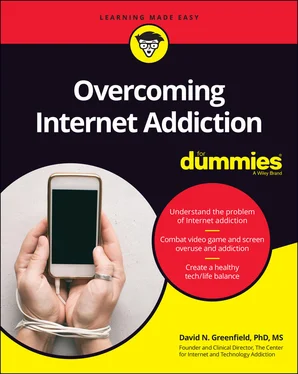These experiences aren’t a coincidence. They are reflections of some of the weaknesses of Internet interactions for social and academic communication. The Internet is best at connecting people with information and services, but it leaves people yearning for more depth and breadth when all is said and done. Perhaps it is best said that our expectations for a two-dimensional experience may be higher than what an Internet screen can deliver.
The Human Factor: The Internet as a Digital Drug
People sometimes want to know how the Internet and digital screens can be addictive. After all, how can you get addicted to a screen behavior? Part of the reason for this question is that it evolves from the idea that addiction is about ingesting a substance and that it is the substance itself that creates the addiction through the body’s physical dependence on it.
 The problem with this analysis is that it’s wrong. This isn’t how addiction really works. Yes, the body can become physiologically dependent on a substance (drugs or alcohol), but if that is what solely created an addiction, then once people detox from the substance, the addiction should be gone. However, this is not what typically happens. Addiction is the combination of many variables that involve learning, memory, emotions, social factors, physiology, behavior, and neurobiology. Often there are co-occurring psychiatric problems that contribute to an addiction, or the addiction may be a way to deal with emotional pain or negative circumstances. Let’s face it: Addictive behaviors can be an escape.
The problem with this analysis is that it’s wrong. This isn’t how addiction really works. Yes, the body can become physiologically dependent on a substance (drugs or alcohol), but if that is what solely created an addiction, then once people detox from the substance, the addiction should be gone. However, this is not what typically happens. Addiction is the combination of many variables that involve learning, memory, emotions, social factors, physiology, behavior, and neurobiology. Often there are co-occurring psychiatric problems that contribute to an addiction, or the addiction may be a way to deal with emotional pain or negative circumstances. Let’s face it: Addictive behaviors can be an escape.
With addiction, there is always a disruption of the reward system in the brain, but the addictive substance or behavior (in this case, Internet use) is not really the primary issue. It is certainly a factor, but the addiction process is as much about learning to deal with triggers and to manage one’s emotions as anything else, and what we see with excessive screen use is like what we see in many addictions: Addictive behaviors start out as a solution that then becomes another problem.
 Being online is a pleasurable and stimulating activity that impacts the brain’s reward system and elevates dopamine; it has a similar potential to create an addictive experience as drugs and alcohol, although physiological dependence is less of an issue.
Being online is a pleasurable and stimulating activity that impacts the brain’s reward system and elevates dopamine; it has a similar potential to create an addictive experience as drugs and alcohol, although physiological dependence is less of an issue.
Grasping the power of “maybe”
The Internet is the world’s biggest slot machine. The slot machine operates on the power of maybe, and this explains the neurobiology of gambling, and most addictions, in some ways. So how does maybe work in our brains? When you pull the handle of a slot machine, your brain knows that it is going to win something. What it does not know is when and how much, but it does know that eventually there will be a reward of some kind. It learns to expect this reward. This system of reinforcement (or dopamine reward) is called variable ratio reinforcement.
So why wouldn’t you just give someone a win each time they pull the handle or after they pull it a certain number of times? The answer is simply boredom (also called extinction ). B.F. Skinner did groundbreaking research on operant conditioning and found out that unpredictable (variable) rewards create longer-lasting response habits (which is another fancy way of saying addiction). If a reward is given variably and unpredictably, then your brain engages in this activity like nobody’s business.
So how does this work with Internet use? Whenever you go online (or on your smartphone), you never really know what you’re going to find or when you’re going to find it. This is true for email, information surfing, scrolling, gaming, social media, shopping, and porn; virtually anything you search for online has a variability to it — a maybe factor. In essence, the Internet operates on the same variable reinforcement schedule that a slot machine does, and people are neurobiologically conditioned by their devices without really knowing it.
Not only does the brain love maybe, but it also loves newness. Novelty resets our attention and interest. And there is perhaps no better source of information that provides endless variability and novelty than the Internet. Every time you go online (and in a sense, we are always online with our devices), it can feel like a new experience each time you click or tap through your latest impulse.
Seeing how dynamic interaction keeps people coming back for more
Dynamic is a way of saying changeable and interactive — and being able to interact with our devices puts some psychological skin in the game for us. It’s dynamic in that we are driving the interactive process by our clicks, and the cycle is complete when we are responded to by our screens. We self-guide our web adventure, and regardless of whether we are on our smartphone, laptop, tablet, or other device, our Internet journey feels like a dialogue. The AI (artificial intelligence) interfaces by Amazon and Google provide a voice to this interactive exchange, giving the cyber experience a very compelling feel. We now experience the Internet not simply as a source of information, but as having lifelike qualities, and the line between simplistic Internet algorithms and AI is fast eroding. I frequently laugh to myself as I enter discourse with Alexa on my Amazon Echo. I know full well that she is just a machine-learning interface, but she feels real and is thus imbued with the dynamism of humanity.
 Most of us would be hard-pressed to admit that we love being online, but the fact is that many of us do. Some of us may find ourselves becoming addicted to a point that our lives are impacted, while others of us may overuse at times. As I mention in earlier chapters, much of this is not conscious. We are virtually swept away in a tidal wave of intensity, stimulation, interactivity, and endless intermittent reward. The problem with tidal waves, however, is that they can hurt us, and our excessive Internet use can subtly rob us of many aspects of quality living. In more extreme circumstances, once addicted, we see our lives becoming impacted in negative ways that we did not fully appreciate. It is this lack of awareness that blinds us to the slow erosion of our most cherished values, and excessive Internet use can mindlessly peel away our time and attention to a point that we forget what real-time living feels like.
Most of us would be hard-pressed to admit that we love being online, but the fact is that many of us do. Some of us may find ourselves becoming addicted to a point that our lives are impacted, while others of us may overuse at times. As I mention in earlier chapters, much of this is not conscious. We are virtually swept away in a tidal wave of intensity, stimulation, interactivity, and endless intermittent reward. The problem with tidal waves, however, is that they can hurt us, and our excessive Internet use can subtly rob us of many aspects of quality living. In more extreme circumstances, once addicted, we see our lives becoming impacted in negative ways that we did not fully appreciate. It is this lack of awareness that blinds us to the slow erosion of our most cherished values, and excessive Internet use can mindlessly peel away our time and attention to a point that we forget what real-time living feels like.
Part 2
Breaking Down Addictive Technologies
IN THIS PART …
Define the addictive nature of social media and how social validation looping keeps you endlessly viewing, posting, and commenting on your social media apps and websites.
Check out the growing phenomenon of streamed online entertainment and the addictive nature of consuming content in this growing Internet-based format.
Recognize the addictive nature of video gaming and how games are designed to capture more than your imagination. Nearly three out of four households in the United States have someone who video games — that is, according to 2020 statistics, about 214 million people — and for most, it’s a fun form of entertainment. However, a small percentage of people find themselves lost in their game world without finding a way out.
Читать дальше

 The problem with this analysis is that it’s wrong. This isn’t how addiction really works. Yes, the body can become physiologically dependent on a substance (drugs or alcohol), but if that is what solely created an addiction, then once people detox from the substance, the addiction should be gone. However, this is not what typically happens. Addiction is the combination of many variables that involve learning, memory, emotions, social factors, physiology, behavior, and neurobiology. Often there are co-occurring psychiatric problems that contribute to an addiction, or the addiction may be a way to deal with emotional pain or negative circumstances. Let’s face it: Addictive behaviors can be an escape.
The problem with this analysis is that it’s wrong. This isn’t how addiction really works. Yes, the body can become physiologically dependent on a substance (drugs or alcohol), but if that is what solely created an addiction, then once people detox from the substance, the addiction should be gone. However, this is not what typically happens. Addiction is the combination of many variables that involve learning, memory, emotions, social factors, physiology, behavior, and neurobiology. Often there are co-occurring psychiatric problems that contribute to an addiction, or the addiction may be a way to deal with emotional pain or negative circumstances. Let’s face it: Addictive behaviors can be an escape. Being online is a pleasurable and stimulating activity that impacts the brain’s reward system and elevates dopamine; it has a similar potential to create an addictive experience as drugs and alcohol, although physiological dependence is less of an issue.
Being online is a pleasurable and stimulating activity that impacts the brain’s reward system and elevates dopamine; it has a similar potential to create an addictive experience as drugs and alcohol, although physiological dependence is less of an issue.










